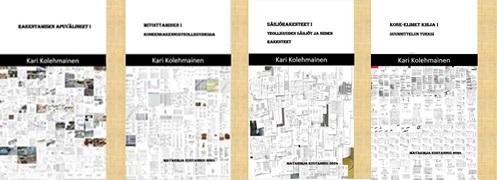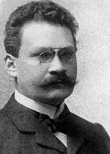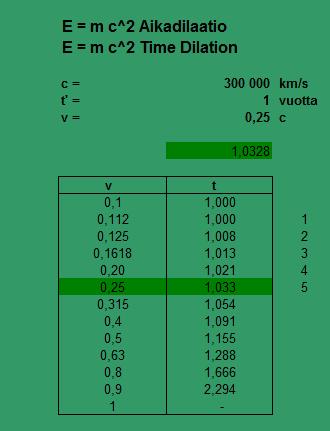Aika neljäs ulotteisuusTime the Fourth DimensionalityUlotteisuudet - Dimensionalities1-ulotteisuus liike etenevänä, kuten juoksu eteenpäin One-dimensionality progressive movement, such as running forward 2-ulotteisuus pinta-ala käsitteen kautta, voima ja vahvuus Two-dimensionality through the concept of area, force and strength 3-ulotteisuus tilavuus Three-dimensionality volume 4-ulotteisuus aika, kuten Hermann Minkowski sen ymmärsi Four-dimensionality time, such as Hermann Minkowski understood itHermann Minkowski
Opiskelu Sveitsissä sujui Albert Einsteiniltä kohtalaisesti. Hermann Minkowskin matematiikan luennot Einstein laisti, uskoen ettei myöhemmin tarvitsisi korkeampaa matematiikkaa. Tätä hän jälkeenpäin katui. Kun Albert Einstein algebrallisesti esitteli erityisen suhteellisuusteorian vuonna 1905, Hermann Minkowski osoitti entiselle oppilaalleen, että sen voi ymmärtää myös geometrisesti teoriana neliulotteisesta aika-avaruudesta. Myöhemmin Albert Einstein havaitsi, että geometrinen näkemys avaruusaikaan olisi tarpeen täydentämään omaa myöhempää työtä yleisenä suhteellisuusteoriana (1915). Suhteellisuuden kannalta huomattavaa on Albert Einsteinin esittäneen saman algebrallisesti, jonka Hermann Minkowski esitti geometrisesti.
Albert Einstein study in Switzerland progressed reasonably well. Hermann Minkowski's mathematics lectures Einstein skipped, believing that he had no use for a higher level mathematics. This he afterwards regretted. When Albert Einstein algebraically presented the special theory of relativity in 1905, Hermann Minkowski showed to his former student that it could also be understood geometrically as a theory of four-dimensional space-time. Later Albert Einstein realized that a geometrical view of space-time would be necessary in order to complete his own later work in general relativity (1915). The proportionality is significant in terms of Albert Einstein presented the same algebraically by the Hermann Minkowski was able to provide geometrically. _____________________________________ Laskennan ajatus on, kuten yllä mainitussa tekstissä. Ilmiöitä voidaan tarkastella mittaamalla, laskea ja esittää geometrisesti. Kuinka laskemme kahdensadan metrin juoksun maailmanennätyksen. Tätä fysiikka ei laske? Calculating idea is the same as in the above text. The phenomena can be examined by measuring, calculate and display geometrically. How does we calculate the two-hundred-meter world record? This physics does not calculate? Esimerkki yksiulotteisuudesta - Example of one-dimensionality Lyhyet juoksumatkat - Short Run EventsKuvio esittää juostavien matkojen noudattavan Pascalin kolmiota. The figure shows the lengths of the events to follow Pascal's triangle. 1 1 1 x 100 m = 100 m 2 1 1 2 x 100 m = 200 m 4 1 2 1 4 x 100 m = 400 m 8 1 3 3 1 8 x 100 m = 800 m 16 1 4 6 4 1 16 x 100 m = 1600 m (maili /mile) Tämä on näkemisen geometriaa nähdä lyhyet juoksumatkat This is visual geometry to see short run events. Fibonacci numerot - Fibonacci numbers 1 - 1 - 2 - 3 - 5 - 8 - 13 - 21 - 34 - 55 - .... Fibonaccin lukujono alkaa 1 - 1 - 2... Pascalin kolmio alkaa saman kaltaisesti. Fibonacci Numbers start 1 - 1 - 2 ... Pascal's Triangle has the same form.
100 m + 100 m = 200 m Yleisurheilun 100 m juoksu - Athletic Event 100 m Race
100 m juoksun ME-aika on 9,58 s. The World Record of 100 m is 9,58 sec. 200 m ME - 200 m WR2 x 9,58 sec = 19,16 s (ME 19,19 s) 2 x 9,58 sec = 19,16 sec (World Record 19,19 sec) 100 m + 100 m = 200 m 1 - 1 - 2
Juostessa ensimmäinen 100 metriä, tapahtuu matkalla väsymistä. Toivon teidän tietävän, ettei maailmassa ole juoksijaa, joka pystyy täysillä juoksemaan sata metriä. Ilman väsymistä aika olisi oletettavasti seuraavan laskelman mukainen. While running the first 100 meters, takes place on the way to fatigue. I hope you know that the runners in the world are not capable of fully running a hundred meters. Without fatigue time would presumably be in accordance with the following calculation. 9,58 s / 1,0328 = 9,276 s. 200 metrin matkalla, kun väsyminen huomioidaan When 200 meters run, taking fatigue into accoun
ME -tuuliolosuhteet - WR Wind Conditions
100 m: Tuuli / Wind + 0,9 m/s 200 m: Tuuli / Wind - 0,3 m/s Esimerkiksi tuuli tekee eron aikaan 19,16 s = 19,19 s. Ymmärrätte, että tämä on ainoa tapa laskea tämän kaltaisia ilmiöitä kuten juoksutapahtumat. Aikadilaation kautta laskenta muodostuu osaksi fysiikkaa. Molemmat maailmanennätykset ovat Usain Boltin nimissä, joka tekee ajoista vertailtavaa. For example wind makes the difference 19.16 s = 19.19 s. Of course you understand that this only a way to calculate this kind of phenomena like run events. Through time dilation the calcalation is a part of physics. Both WR times belong to Usain Bolt and this makes times comparable. 13.11 2014*9:39 E-mail: karikolehmainen53@gmail.com |



